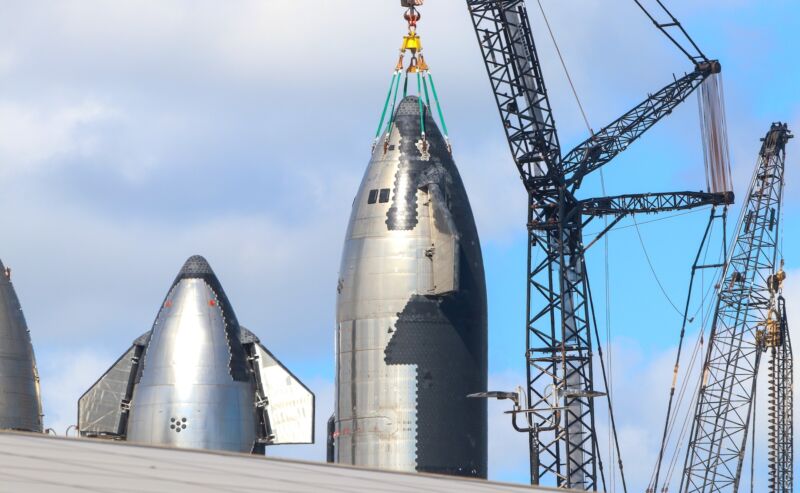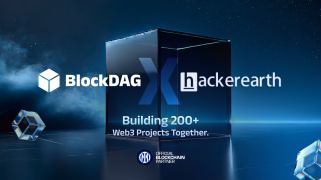
SpaceX appears on track for at least a preliminary propellant transfer test next year.
SpaceX and NASA could take a tentative step toward orbital refueling on the next test flight of Starship, but the US space agency says officials haven't made a final decision on when to begin demonstrating cryogenic propellant transfer capabilities that are necessary to return astronauts to the Moon.
SpaceX 似乎預計在明年至少進行一次初步的推進劑轉移測試。SpaceX 和NASA 可能會在Starship 的下一次試飛中邁出試探性的一步,進行軌道加油,但美國航天局表示,官員們尚未就何時進行最終決定開始展示將太空人送回月球所需的低溫推進劑傳輸能力。
NASA is keen on demonstrating orbital refueling technology, an advancement that could lead to propellant depots in space to feed rockets heading to distant destinations beyond Earth orbit. In 2020, NASA announced agreements with four companies—Lockheed Martin, United Launch Alliance, SpaceX, and a Florida-based startup named Eta Space—to prove capabilities in the area of refueling and propellant depots using cryogenic propellants.
美國太空總署熱衷於展示軌道加油技術,這項進步可能會導致在太空中建立推進劑庫,為前往地球軌道以外遙遠目的地的火箭提供燃料。 2020 年,NASA 宣布與四家公司(洛克希德馬丁公司、聯合發射聯盟、SpaceX 和一家位於佛羅裡達州的新創公司Eta Space)達成協議,以證明使用低溫推進劑在加油和推進劑庫領域的能力。
These cryogenic fluids—liquid hydrogen, methane, and liquid oxygen—must be kept at temperatures of several hundred degrees below zero, or they turn into a gas and boil off. Russian supply freighters regularly refuel the International Space Station with hydrazine and nitrogen tetroxide, room-temperature rocket propellants that can be stored for years in orbit, but rockets using more efficient super-cold propellants have typically needed to complete their missions within hours.
這些低溫流體——液氫、甲烷和液態氧——必須保持在零以下幾百度的溫度,否則它們會變成氣體並蒸發。俄羅斯補給貨船定期為國際太空站補充燃料,肼和四氧化二氮是室溫火箭推進劑,可以在軌道上儲存數年,但使用更有效率的超冷推進劑的火箭通常需要在數小時內完成任務。
NASA and industry engineers want to extend this lifetime to days, weeks, or months, but this requires new technologies to maintain the propellants at cryogenic temperature and, in some cases like Starship, to transfer the propellants from one vehicle to another.
NASA 和行業工程師希望將其壽命延長至數天、數週或數月,但這需要新技術將推進劑維持在低溫下,並且在某些情況下(例如Starship)將推進劑從一輛車轉移到另一輛車上。
NASA and several companies are funding efforts in this area, called cryogenic fluid management. NASA's agreements from 2020 committed more than $250 million in government funding for cryogenic fluid management tests in space. These funding agreements announced in October 2020, called "Tipping Point" awards, require substantial private funding from the companies participating in the demonstrations.
美國太空總署和幾家公司正在資助這一領域的工作,稱為低溫流體管理。 NASA 從 2020 年起簽署的協議承諾為太空低溫流體管理測試提供超過 2.5 億美元的政府資助。這些於 2020 年 10 月宣布的資助協議被稱為「引爆點」獎,需要參與示威活動的公司提供大量私人資金。
According to John Dankanich, who leads NASA's efforts in developing new capabilities for in-space transportation, there are "major technical obstacles" for cryogenic fluid management. The real challenge, he said, will be in validating things like automated couplers, flow meters, and advanced insulation all work together in microgravity. These, along with other technologies, are "highly interdependent" on one another to make cryogenic refueling a reality, he said.
領導美國太空總署開發太空運輸新能力的約翰·丹卡尼奇表示,低溫流體管理存在「重大技術障礙」。他說,真正的挑戰是驗證自動耦合器、流量計和先進絕緣材料等在微重力下都能協同工作。他說,這些技術與其他技術“高度相互依賴”,使低溫加油成為現實。
Individual technologies necessary for in-orbit cryogenic refueling are at a stage of development where they are "ready now to go into flight systems," Dankanich said, either with a demonstration in space or on an operational spacecraft.
丹卡尼奇說,在軌低溫加油所需的各項技術正處於開發階段,“現在已準備好進入飛行系統”,要么在太空中進行演示,要么在運行的航天器上進行演示。
First, small steps
By the fourth anniversary of those awards, only SpaceX appears to have a chance to complete the tasks outlined in its "Tipping Point" award, valued at $53 million.
This test would involve transferring super-cold propellant from one tank to another inside a Starship spacecraft. It's a precursor to future, more complex demonstrations involving two giant Starships docked together in Earth orbit. Then SpaceX will be ready to send a Starship toward the Moon for a test landing without astronauts onboard. Once that is successful, NASA will clear Starship for a crew landing on the agency's Artemis III mission, marking the astronauts' return to the lunar surface for the first time since 1972.
首先,小步驟到這些獎項頒發四週年之際,似乎只有SpaceX 有機會完成價值5300 萬美元的「引爆點」獎項中概述的任務。這項測試將涉及將超冷推進劑從一個儲罐轉移到另一個儲槽星艦飛船內。這是未來更複雜的演示的先驅,涉及兩艘巨型星際飛船在地球軌道上對接在一起。然後,SpaceX 將準備將一艘星際飛船送向月球,進行沒有太空人在場的測試著陸。一旦成功,美國太空總署將允許星際飛船太空人登陸該機構的阿耳忒彌斯 III 任務,這標誌著太空人自 1972 年以來首次返回月球表面。
That's easier said than done; all worthy projects require a first step. That could happen as soon as the next full-scale test flight of SpaceX's gigantic Super Heavy booster and Starship rocket, a stainless steel launcher that stands nearly 400 feet (121 meters) tall. SpaceX has flown the rocket twice, most recently on November 18, when the Starship upper stage reached space for the first time before self-destructing just short of orbital velocity. This test flight was largely successful, achieving several key milestones such as stage separation and demonstrating improved reliability of the rocket's methane-fueled Raptor engines.
說起來容易做起來難;所有有價值的項目都需要邁出第一步。這可能會在 SpaceX 的巨型超重型助推器和 Starship 火箭(高度近 400 英尺(121 公尺)的不銹鋼發射器)下一次全面試飛時發生。 SpaceX 已經發射了兩次火箭,最近一次是在 11 月 18 日,當時 Starship 上級首次進入太空,然後在接近軌道速度時自毀。這次試飛取得了巨大成功,實現了幾個關鍵里程碑,例如級分離,並展示了火箭甲烷燃料猛禽引擎可靠性的提高。
SpaceX has a $2.9 billion contract with NASA to provide a commercial Human Landing System (HLS) derived from Starship for the Artemis III mission, the first human landing mission planned during NASA's Artemis program. The readiness of the Starship landing craft and new commercial spacesuits are widely seen as drivers of the schedule for Artemis III, which is at risk of a delay from late 2025.
SpaceX 與 NASA 簽訂了價值 29 億美元的合同,為 Artemis III 任務提供源自 Starship 的商業載人著陸系統 (HLS),這是 NASA Artemis 計劃期間計劃的首次載人著陸任務。星艦登陸艇和新型商業太空服的準備就緒被廣泛視為阿耳忒彌斯 III 計畫的推動因素,該計畫有可能從 2025 年底開始推遲。
Lakiesha Hawkins, deputy associate administrator for NASA's Moon to Mars program office, discussed the Artemis schedule Monday with a committee from the National Academies charged with reviewing the agency's workforce, infrastructure, and technology programs.
美國太空總署月球到火星計畫辦公室副副主任拉基莎霍金斯週一與負責審查該機構勞動力、基礎設施和技術項目的美國國家科學院委員會討論了阿爾忒彌斯計畫。
Hawkins did not verbally address SpaceX's plans for the next Starship test flight, but one of her slides noted SpaceX is "moving quickly" toward the third Super Heavy/Starship launch, and that this flight "will include a propellant transfer demonstration."
霍金斯沒有口頭提及SpaceX 的下一次星際飛船試飛計劃,但她的一張幻燈片指出,SpaceX 正在「快速推進」第三次超重型/星際飛船發射,並且這次飛行「將包括推進劑轉移演示」。
However, Jimi Russell, a NASA spokesperson, suggested to Ars this is still only a possibility. When it does happen, the tank-to-tank propellant transfer within Starship will demonstrate moving 10 metric tons of liquid oxygen, according to the 2020 Tipping Point award terms. SpaceX is collaborating with NASA's Glenn Research Center and Marshall Space Flight Center on the demonstration.
然而,NASA 發言人吉米·拉塞爾 (Jimi Russell) 向 Ars 表示,這仍然只是一種可能性。根據 2020 年引爆點獎勵條款,當它確實發生時,星際飛船內的坦克到坦克推進劑轉移將證明可以移動 10 噸液態氧。 SpaceX 正在與 NASA 格倫研究中心和馬歇爾太空飛行中心合作進行演示。
"NASA and SpaceX are reviewing options for the demonstration to take place during an integrated flight test of Starship and the Super Heavy rocket," Russell said in a statement. "However, no final decisions on timing have been made."
拉塞爾在一份聲明中表示:“美國宇航局和 SpaceX 正在審查在星際飛船和超重型火箭綜合飛行測試期間進行演示的選擇。” “但是,尚未就時間做出最終決定。”
Elon Musk, the company's founder and CEO, said on November 19 that hardware for the next Super Heavy/Starship test should be ready in three to four weeks. That projection seems dubious because SpaceX hasn't moved any pieces of the rocket to the launch pad for pre-flight testing, but a test flight early next year appears realistic.
該公司創始人兼執行長 Elon Musk 11 月 19 日表示,下一次超重型/星艦測試的硬體應在三到四週內準備就緒。這項預測似乎很可疑,因為 SpaceX 尚未將火箭的任何部件移至發射台進行飛行前測試,但明年初的試飛似乎是現實的。
Other factors that could play into the Starship launch schedule include tune-ups or fixes to resolve problems that occurred on the November 18 test flight and receiving a new launch license from the Federal Aviation Administration.
可能影響星艦發射時間表的其他因素包括調整或修復以解決 11 月 18 日試飛中出現的問題以及獲得美國聯邦航空管理局的新發射許可證。
When SpaceX tries transferring 10 metric tons of propellant from tank to tank inside Starship, it will be at a scale never before attempted in space. But it's a small fraction of the amount of fuel and oxidizer needed to fill a Starship spacecraft in orbit. The ship's total propellant capacity is some 1,200 metric tons. After the tank-to-tank demonstration, SpaceX will attempt a ship-to-ship propellant transfer between two Starships linked together in Earth orbit.
當 SpaceX 嘗試在 Starship 內將 10 噸推進劑從一個儲罐轉移到另一個儲罐時,其規模將是以前在太空中從未嘗試過的。但這只是填充軌道上的星艦太空船所需的燃料和氧化劑量的一小部分。該船的推進劑總容量約為 1,200 噸。在坦克對坦克演示之後,SpaceX 將嘗試在地球軌道上連接在一起的兩艘星際飛船之間進行船舶推進劑轉移。
"That’s really when we start maturing the systems, and when it really gets exciting for HLS, because those are the building blocks that we need and, frankly, it’s never been done successfully in orbit," said Lisa Watson-Morgan, NASA's HLS program manager, in an interview with Ars last month.
NASA HLS 計畫的麗莎·沃森-摩根(Lisa Watson-Morgan) 表示:「這正是我們開始讓系統成熟的時候,也是HLS 真正令人興奮的時候,因為這些是我們需要的建造模組,而且坦白說,它從未在軌道上成功完成過。」上個月接受 Ars 採訪時。
This discussion of propellant transfer leaves out critical work on Starship's life support system needed to accommodate crews on the lunar surface. SpaceX also needs to move forward with more Raptor engine testing, but the company recently completed a ground test to confirm it can reignite a Raptor engine in the extreme cold conditions resulting from extended time in space. SpaceX has also completed Raptor test-firings at different throttle settings to simulate how the engines must perform during a descent burn to reach the lunar surface.
關於推進劑轉移的討論忽略了星艦在月球表面容納船員所需的生命維持系統的關鍵工作。 SpaceX 還需要推進更多的猛禽引擎測試,但該公司最近完成了一次地面測試,以確認它可以在太空中長時間停留而導致的極端寒冷條件下重新點燃猛禽引擎。 SpaceX 還完成了猛禽在不同油門設定下的試射,以模擬引擎在到達月球表面的下降燃燒過程中必須如何運作。
Others in the running
其他人在奔跑中
The other companies working with NASA on cryogenic fluid management are still at least a couple of years away from any meaningful flight demonstrations.
與美國太空總署合作進行低溫流體管理的其他公司距離任何有意義的飛行演示至少還需要幾年的時間。
Lockheed Martin's demo, expected to use liquid hydrogen, is scheduled for 2025 and will test 15 key cryo fluid management technologies. Eta Space is developing a small-scale fuel depot to demonstrate long-duration cryogenic storage of liquid oxygen for nine months. This mission, known as LOXSAT, is scheduled to launch with Rocket Lab in 2025, according to Dankanich.
洛克希德馬丁公司的演示預計將使用液氫,計劃於 2025 年進行,並將測試 15 項關鍵的低溫流體管理技術。 Eta Space 正在開發一個小型燃料庫,以演示液態氧的長期低溫儲存長達九個月。 Dankanich 表示,這項名為 LOXSAT 的任務計畫於 2025 年與 Rocket Lab 一起發射。
Liquid hydrogen is the smallest molecule and needs to be stored at colder temperatures than methane or liquid oxygen. It is the most efficient rocket fuel in common use, but is prone to leaks.
液氫是最小的分子,需要在比甲烷或液態氧更低的溫度下儲存。它是常用的最高效的火箭燃料,但很容易洩漏。
United Launch Alliance is working on a liquid hydrogen/liquid oxygen "smart propulsion cryogenic system" on a Vulcan Centaur upper stage, testing precise tank pressure control, tank-to-tank transfer, and multi-week propellant storage, according to NASA. Dankanich said Monday ULA's flight demonstration is scheduled for 2026.
據美國宇航局稱,聯合發射聯盟正在火神半人馬座上級開發液氫/液氧“智能推進低溫系統”,測試精確的儲罐壓力控制、儲罐到儲罐的傳輸以及數週的推進劑儲存。丹卡尼奇週一表示,ULA 的飛行表演定於 2026 年進行。
Like Starship, Blue Origin's human-rated lunar lander for Artemis will rely on orbital refueling but with liquid hydrogen. Blue Origin's approach to cryogenic fluid management involves actively controlling the temperature of liquid hydrogen using cryocoolers, while SpaceX is using passive thermal control on Starship.
與「星際飛船」一樣,藍色起源的阿耳忒彌斯載人月球登陸器也將依靠軌道加油,但使用液態氫。 Blue Origin 的低溫流體管理方法涉及使用低溫冷卻器主動控制液態氫的溫度,而 SpaceX 則在 Starship 上使用被動熱控制。
Dankanich said Blue Origin plans "multiple interim demonstrations" with its cryogenic systems before its lander is certified to carry astronauts to the Moon's surface, but he didn't offer a schedule for those flight tests leading up to Blue Origin's first human landing mission, slated for no sooner than 2029.
丹卡尼奇表示,藍色起源計劃在其著陸器獲得將宇航員運送到月球表面的認證之前,對其低溫系統進行“多次臨時演示”,但他沒有提供藍色起源首次載人登陸任務之前的飛行測試時間表。不早於 2029 年。
Aside from technical hurdles, Dankanich said there's another potential barrier to widespread advancements in cryogenic refueling and propellant depots. For most of the tech demos, NASA is partnering with companies on a cost-sharing basis, reducing the cost to taxpayers. NASA would like to use data from the demonstrations to provide "ground truth" for models to predict the behavior of cryogenic fluids in space. Because NASA is a government agency, these models would be available to a broad cross-section of researchers and engineers.
丹卡尼奇表示,除了技術障礙之外,低溫加油和推進劑庫的廣泛進步還有另一個潛在障礙。對於大多數技術演示,美國宇航局正在與公司在成本分攤的基礎上合作,從而降低納稅人的成本。美國宇航局希望利用演示數據為模型提供“地面真相”,以預測太空中低溫流體的行為。由於 NASA 是一個政府機構,因此這些模型將可供廣泛的研究人員和工程師使用。
Under the terms of these public-private partnerships, industry retains ownership, and these companies may consider details about their technology proprietary, limiting NASA's ability to share lessons learned with academic institutions or other outside groups.
根據這些公私合作夥伴關係的條款,工業界保留所有權,這些公司可能會考慮有關其專有技術的細節,從而限制了 NASA 與學術機構或其他外部團體分享經驗教訓的能力。
“In some cases, we can't force them to even instrument the systems in the way that we need them instrumented in order to get the data that we would need to validate," Dankanich said. "If they're willing to provide the telemetry that we need, then we may, on the NASA side, be able to get some of that information. But we can't disclose the design details or the specifics to the community, which is necessary for model validation.
丹卡尼奇說:「在某些情況下,我們甚至不能強迫他們按照我們需要的方式對系統進行檢測,以獲得我們需要驗證的數據。」「如果他們願意提供我們需要的遙測技術,那麼我們在美國宇航局方面可能能夠獲得其中一些資訊。但我們不能向社群透露設計細節或具體細節,這是模型驗證所必需的。
"Data right restrictions are a big challenge with the way that we're procuring all of our cryogenic fluid management systems," Dankanich said. "At the same time, the outlook is pretty good, right? We do have the SpaceX large-scale cryo settling propellant transfer planned for next year."
「數據權限制對於我們採購所有低溫流體管理系統的方式來說是一個巨大的挑戰,」丹卡尼奇說。 “與此同時,前景相當不錯,對吧?我們確實計劃明年進行 SpaceX 大規模低溫沉降推進劑轉移。”


 Optimisus
Optimisus Optimisus
Optimisus Optimisus
Optimisus Thecryptoupdates
Thecryptoupdates DogeHome
DogeHome The Crypto Times
The Crypto Times Coincu
Coincu Optimisus
Optimisus Coin_Gabbar
Coin_Gabbar






















